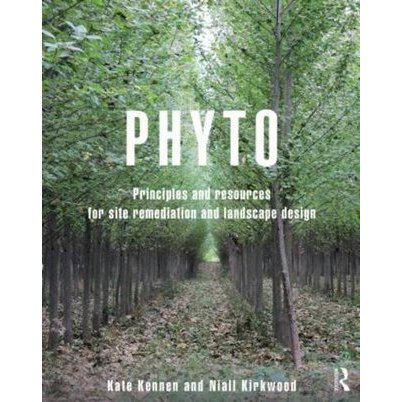Kate Kennen and Niall Kirkwood
Routledge

In Phyto, Kennen and Kirkwood target a larger audience to make the complexity of phytotechnologies more approachable for the landscape design profession. This applies especially to students of landscape architecture and planning design students in general, practitioners in landscape architecture, planning, or environmental engineering, the horticultural industry, and landscape construction or land care associations. The authors have synthesized hundreds of scientific articles from prominent sources such as the International Journal of Phytoremediation and research-based landmark books on phytoremediation. They worked with forty-seven highly accomplished specialists in bioremediation and revitalization of postindustrial landscapes, who contributed by synthesizing scientific content, providing case studies, and providing overall review. Prominent contributors are environmental engineering pioneers such as Steven Rock and Jerald Schnoor.
Kennen and Kirkwood have organized the book into six chapters. The first chapter provides an overview of phytotechnologies and their current applications in the environment and their anticipated future use. The second chapter reviews the fundamentals of the scientific processes involved in phytotechnology remediation (Figures 1 and 2). This chapter deals with general processes in the plant, gives a brief overview of contaminant types, describes the processes or mechanisms in the plant that assist in the remediation of contaminants, covers installation characteristics, and introduces the challenges and limitations of field application. The third chapter classifies the contaminants commonly addressed by phytotechnology approaches and provides a guide to plant selection that is applicable to all climate zones in North America. This chapter adds complimentary case studies for all classified contaminants to further illustrate successful phytotechnology installations in praxis (Figure 3). Chapter 4 outlines the interrelationships of specific contaminants with eighteen different phytotechnology planting typologies or “Phytotypologies.” Each typology is introduced with its corresponding major phytoremediation mechanisms. These are remediation processes that take place within or around the plant, the target media—for example, soils or groundwater—and the contaminants addressed/not addressed. Additionally, typical applications of the planting typology are briefly described in land-use scenarios, as well as general plant-selection criteria and other design considerations. The eighteen phytotypologies depicted can be used as interchangeable modules in the design process to address the specific challenges of the site, including contamination (Figures 4–7).
Rather than beginning with the first chapters and the introduction to phytotechnologies, it is possible to approach the subject with the land-use scenarios in the fifth chapter. These provide a brief introduction without omitting potential sources of contamination, a listing of major contaminants, and tangible spatial solution with an assemblage of possible planting typologies. The informative tables with short descriptions reference other more specific and detailed sections in the book. The continuous color code in the book for contaminants is helpful to readers—especially those who are new to the complexity of phytotechnology. Obviously these planting typologies need to be expanded, connected, and combined creatively to create a coherent and more artistic design solution in the landscape. While the landscapes and planting zones addressed in Phyto are generally developed from a North American perspective, they can be applied in other settings worldwide with similar constellations.
While Kennen and Kirkwood identify nonspecialists of phytotypologies as targeted readers, it would be great if the book could also inspire scientists and engineers to reach out to the landscape design profession to explore the aesthetic and cultural potential of phytotechnologies. This is important when related to more fundamental questions of aesthetics, ecology, and sustainability. Such issues have to be addressed if we want landscapes that perform phytotechnologies to be valued and accepted. The book targets the education of landscape architecture and other design fields to become competent experts within the broader context of brownfield redevelopment and the creation of healthy environments. Phyto has the potential to open new chapters in landscape architecture.
How to Cite this Article: Sleegers, Frank. Review of Phyto: Principles and Resources for Site Remediation and Landscape Design, by Kate Kennen and Niall Kirkwood. JAE Online. September 1, 2016. https://jaeonline.org/issue-article/phyto/.






